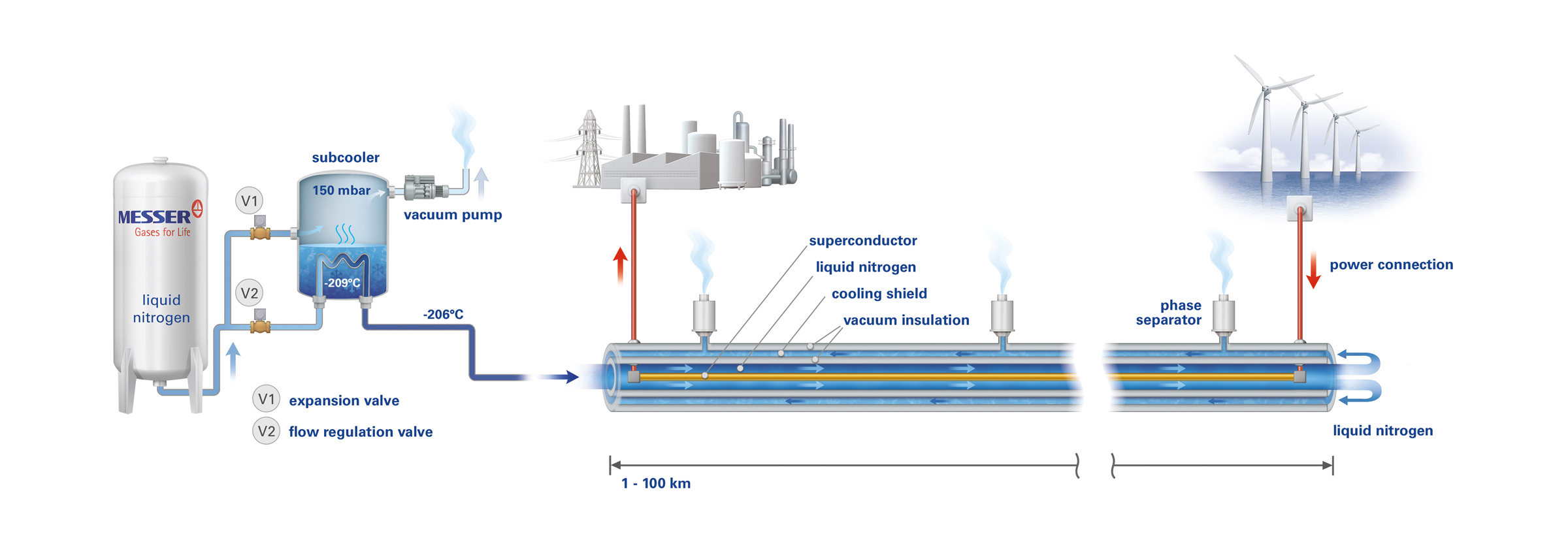By: Dr Friedhelm Herzog and Thomas Kutz, Messer Group
Reading time: 5 Minutes
◤ RESEARCH
Efficient cooling for long superconducting power cables
The world needs more and more electricity – and power lines. But there is less and less room for new transmission line routes. Innovative superconductors can get through the bottlenecks.
When electric current flows along a conventional wire, it must overcome the electrical resistance of the cable. That eats up part of the energy, generating waste heat and electric fields as undesirable byproducts. Superconductivity avoids all these problems: discovered in 1911, metallic superconductors no longer have any resistance at temperatures near absolute zero ( -273 degrees Celsius), allowing current to flow without losses. At such low temperatures, however, the cooling takes a lot of energy.
Superconductivity saves space and transformers
Superconductors made of special ceramic materials achieve superconductivity already at a higher temperature – near the boiling point of liquid nitrogen (-196 degrees Celsius). We refer to these as “high-temperature” superconductors. Their discovery earned the Nobel Prize in Physics in 1987. This type of power cable can be used to solve a whole series of power transmission problems. The considerable transformation losses, for example, that occur in addition to the transmission losses: for conventional overland lines, high voltage is used to transmit the energy at the lowest possible current; electrical voltage from wind and solar parks is first stepped up and then back down again for the consumer.
When electricity from solar power is used to produce green hydrogen, part of the original energy is already lost during transformation (read more about this in our cover story). With a superconductor connection, on the other hand, the current plays no role: the electric current flows without transformation and loss-free from the solar park to the electrolyzer, no matter whether it is high or low.
Elsewhere, superconductivity can enable previously impossible new power transmission line routes for the first time. Conventional high-voltage lines require a lot of space, above and below ground. In densely populated regions, planning soon reaches the limits imposed by the applicable distance regulations. Due to their waste heat and the inevitable electric fields, even new underground lines cannot be laid everywhere. So, thanks to the new technology, the power suppliers can allow for sections with superconductors at critical points – the only way to obtain authorization. The sticking point with superconductors is the cooling. It must not devour more energy than the loss-free transmission saves. The current-carrying capacity of high-temperature superconductors increases as their temperature decreases. That’s why Messer developed a cooling unit that supplies the cryogenic liquid nitrogen at a temperature below its normal boiling point (-196 degrees Celsius). It can be lowered to near the freezing point of nitrogen (-210 degree Celsius). The first unit of this type went into commercial operation already in 2014 and has been working smoothly and reliably ever since.
Proven superconductor cooling
The superconducting cables are found inside vacuum-insulated pipelines (cryostats), through which the cryogenic liquid flows. The vacuum insulation can shield the cold from the warmer surroundings very effectively but not completely. That’s why continuous additional cooling is required. For that purpose, a recirculation pump supplies “supercooled” liquid nitrogen – its temperature, at -206 degrees Celsius, is well below the boiling point – to the cable cryostats. At the other end of the cable run, the now somewhat warmer liquid nitrogen is redirected back through a return line to the pump. The nitrogen then flows through a heat exchanger installed in the subcooler, where the absorbed heat is removed again.
The subcooler uses liquid nitrogen from the tank as its source of cooling. It is evaporated under vacuum. This maintains an operating temperature of -209 degrees Celsius, 13 degrees below the normal boiling point of nitrogen. The cooling unit must be designed in a way that it can compensate the heat absorbed by the cable cryostat and return line as well as the heat generated by the pumping process. With longer cable sections, intermediate cooling stations are also used. Because those stations can be operated with the liquid nitrogen from the cooling circuit, they require no storage tanks. However, their installation is very costly and complex.
New system minimizes losses
The new cooling system developed by Messer reduces the combined energy losses by up to 50 percent. It works without a return line or a recirculation pump, and intermediate cooling stations are not required. This reduces investment costs significantly. The centerpiece of the cooling concept is an actively cooled cooling shield around the cable cryostats. Drawn through an expansion valve from the storage tank, the nitrogen is evaporated in the subcooler under vacuum conditions, producing a temperature as low as -209 degrees Celsius. At the same time, liquid nitrogen flows from the tank through the heat exchanger in the subcooler. In so doing, liquid nitrogen cools down to about -206 degrees Celsius. No pump is needed: the pressure needed to maintain flow is generated in the tank. The subcooled liquid nitrogen leaving the subcooler now flows through the inner pipe of the cable cryostat, thereby, keeping the superconducting current carriers cold.
As a result of the additional cooling shield, heat intake in the direction of the superconductor is one tenth that of a simple cryostat. So, the liquid nitrogen mass flow required for keeping the superconductor-temperature low is likewise reduced by a factor of ten. The flow pressure drop is even reduced by a factor of 100. At the other end of the cryostat, the nitrogen flow is fed from the superconductor into the cooling shield. There the liquid gas evaporates and generates cooling that compensates the cryostat heat intake. Phase separators (degassers) discharge the nitrogen evaporated in the cooling shield to the atmosphere, thereby, minimizing flow pressure drop in the shield. This technology makes it possible to implement up to 100-kilometer-long, energy-efficient cable runs inexpensively and with very high operational reliability.


